torque SSANGYONG MUSSO 2003 Service Manual
[x] Cancel search | Manufacturer: SSANGYONG, Model Year: 2003, Model line: MUSSO, Model: SSANGYONG MUSSO 2003Pages: 1574, PDF Size: 26.41 MB
Page 858 of 1574

PARKING BRAKE 4G-3
MAINTENANCE AND REPAIR ON-VEHICLE SERVICE PARKING BRAKE Removal & Installation Procedure
1. Disconnect the parking brake indicator switch connector.
2. Disconnect the right and left cable from equalizer whileparking brake lever is released.
3. Unscrew 8 bolts and remove the parking brake lever assembly. Installation Notice Notice
Tighten the bolts with sequence number while the lever is pulled up 4 to 6 notches.
Tightening Torque 8 - 18 Nm
4. Unscrew the frame and lower arm side cable mounting bracket bolts. Installation Notice
Tightening Torque 8 - 18 Nm
Page 860 of 1574
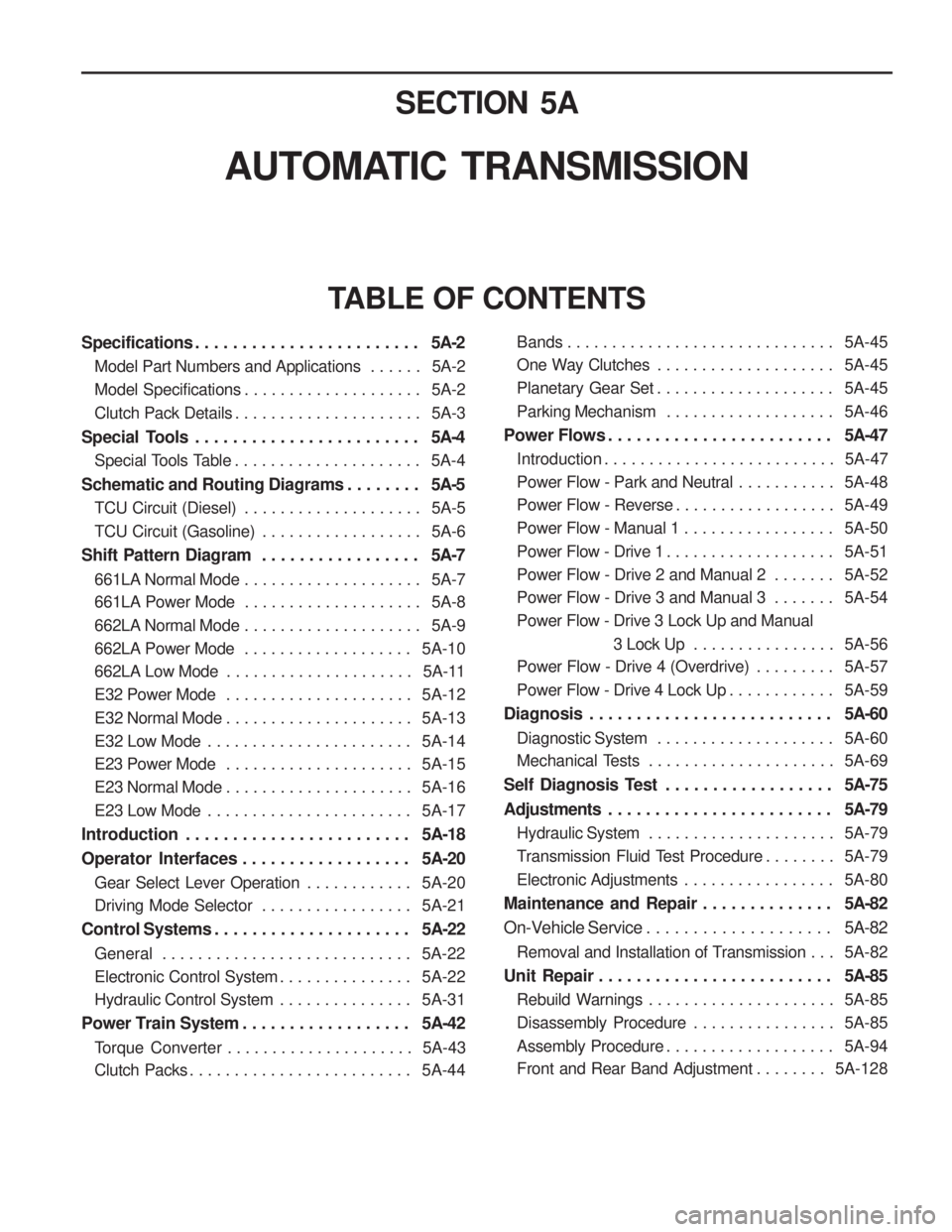
SECTION 5A
AUTOMATIC TRANSMISSION
TABLE OF CONTENTS
Specifications . . . . . . . . . . . . . . . . . . . . . . . . 5A-2
Model Part Numbers and Applications . . . . . . 5A-2
Model Specifications . . . . . . . . . . . . . . . . . . . . 5A-2
Clutch Pack Details . . . . . . . . . . . . . . . . . . . . . 5A-3
Special Tools . . . . . . . . . . . . . . . . . . . . . . . . 5A-4
Special Tools Table . . . . . . . . . . . . . . . . . . . . . 5A-4
Schematic and Routing Diagrams . . . . . . . . 5A-5
TCU Circuit (Diesel) . . . . . . . . . . . . . . . . . . . . 5A-5
TCU Circuit (Gasoline) . . . . . . . . . . . . . . . . . . 5A-6
Shift Pattern Diagram . . . . . . . . . . . . . . . . . 5A-7
661LA Normal Mode . . . . . . . . . . . . . . . . . . . . 5A-7
661LA Power Mode . . . . . . . . . . . . . . . . . . . . 5A-8
662LA Normal Mode . . . . . . . . . . . . . . . . . . . . 5A-9
662LA Power Mode . . . . . . . . . . . . . . . . . . . 5A-10
662LA Low Mode . . . . . . . . . . . . . . . . . . . . . 5A-11
E32 Power Mode . . . . . . . . . . . . . . . . . . . . . 5A-12
E32 Normal Mode . . . . . . . . . . . . . . . . . . . . . 5A-13
E32 Low Mode . . . . . . . . . . . . . . . . . . . . . . . 5A-14
E23 Power Mode . . . . . . . . . . . . . . . . . . . . . 5A-15
E23 Normal Mode . . . . . . . . . . . . . . . . . . . . . 5A-16
E23 Low Mode . . . . . . . . . . . . . . . . . . . . . . . 5A-17
Introduction . . . . . . . . . . . . . . . . . . . . . . . . 5A-18
Operator Interfaces . . . . . . . . . . . . . . . . . . 5A-20
Gear Select Lever Operation . . . . . . . . . . . . 5A-20
Driving Mode Selector . . . . . . . . . . . . . . . . . 5A-21
Control Systems . . . . . . . . . . . . . . . . . . . . . 5A-22
General . . . . . . . . . . . . . . . . . . . . . . . . . . . . 5A-22
Electronic Control System . . . . . . . . . . . . . . . 5A-22
Hydraulic Control System . . . . . . . . . . . . . . . 5A-31
Power Train System . . . . . . . . . . . . . . . . . . 5A-42
Torque Converter . . . . . . . . . . . . . . . . . . . . . 5A-43
Clutch Packs . . . . . . . . . . . . . . . . . . . . . . . . . 5A-44Bands . . . . . . . . . . . . . . . . . . . . . . . . . . . . . . 5A-45
One Way Clutches . . . . . . . . . . . . . . . . . . . .
5A-45
Planetary Gear Set . . . . . . . . . . . . . . . . . . . . 5A-45
Parking Mechanism . . . . . . . . . . . . . . . . . . . 5A-46
Power Flows . . . . . . . . . . . . . . . . . . . . . . . . 5A-47
Introduction . . . . . . . . . . . . . . . . . . . . . . . . . . 5A-47
Power Flow - Park and Neutral . . . . . . . . . . . 5A-48
Power Flow - Reverse . . . . . . . . . . . . . . . . . . 5A-49
Power Flow - Manual 1 . . . . . . . . . . . . . . . . . 5A-50
Power Flow - Drive 1 . . . . . . . . . . . . . . . . . . . 5A-51
Power Flow - Drive 2 and Manual 2 . . . . . . . 5A-52
Power Flow - Drive 3 and Manual 3 . . . . . . . 5A-54
Power Flow - Drive 3 Lock Up and Manual
3 Lock Up . . . . . . . . . . . . . . . . 5A-56
Power Flow - Drive 4 (Overdrive) . . . . . . . . . 5A-57
Power Flow - Drive 4 Lock Up . . . . . . . . . . . . 5A-59
Diagnosis . . . . . . . . . . . . . . . . . . . . . . . . . . 5A-60
Diagnostic System . . . . . . . . . . . . . . . . . . . . 5A-60
Mechanical Tests . . . . . . . . . . . . . . . . . . . . . 5A-69
Self Diagnosis Test . . . . . . . . . . . . . . . . . . 5A-75
Adjustments . . . . . . . . . . . . . . . . . . . . . . . . 5A-79
Hydraulic System . . . . . . . . . . . . . . . . . . . . . 5A-79
Transmission Fluid Test Procedure . . . . . . . . 5A-79
Electronic Adjustments . . . . . . . . . . . . . . . . . 5A-80
Maintenance and Repair . . . . . . . . . . . . . . 5A-82
On-Vehicle Service . . . . . . . . . . . . . . . . . . . . 5A-82
Removal and Installation of Transmission . . . 5A-82
Unit Repair . . . . . . . . . . . . . . . . . . . . . . . . . 5A-85
Rebuild Warnings . . . . . . . . . . . . . . . . . . . . . 5A-85
Disassembly Procedure . . . . . . . . . . . . . . . . 5A-85
Assembly Procedure . . . . . . . . . . . . . . . . . . . 5A-94
Front and Rear Band Adjustment . . . . . . . . 5A-128
Page 861 of 1574
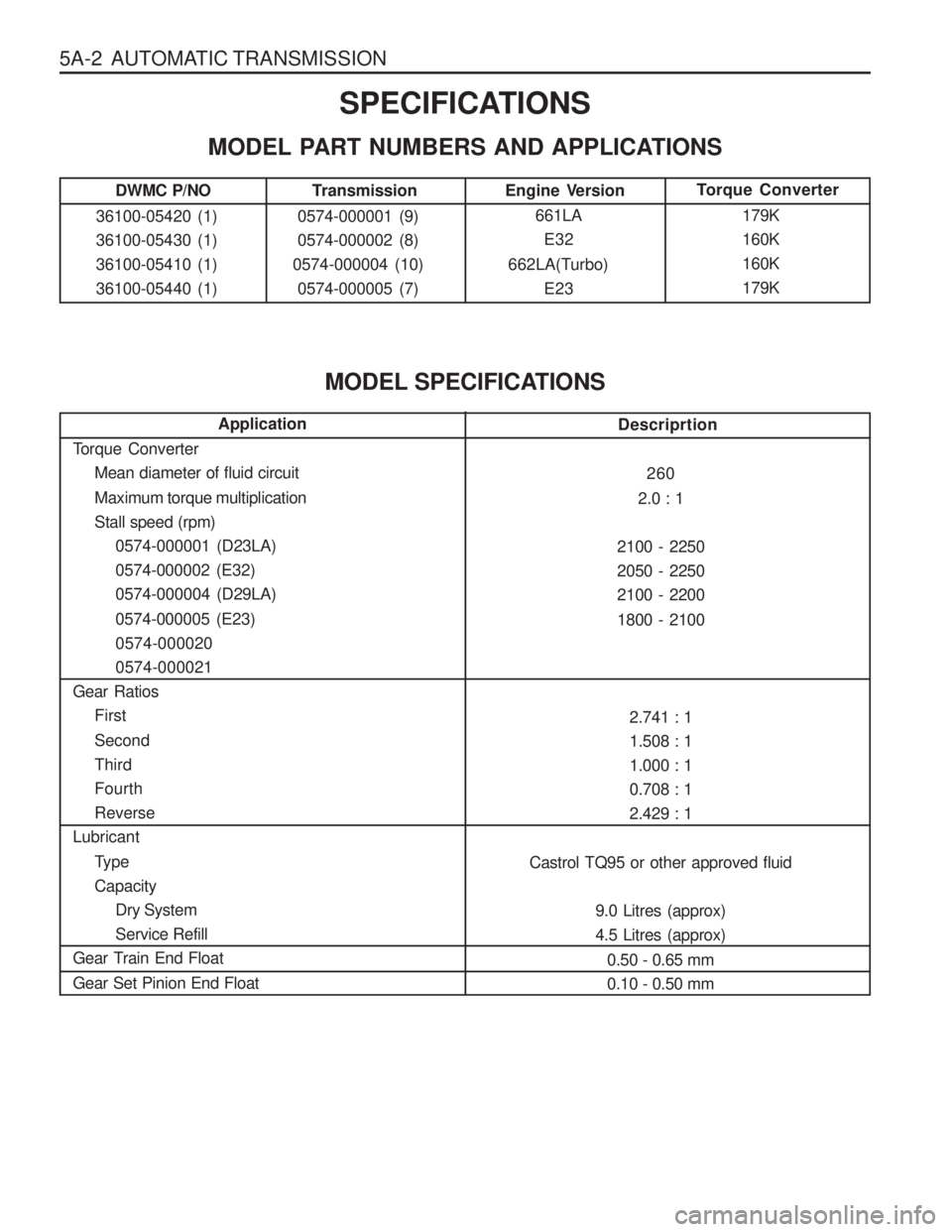
5A-2 AUTOMATIC TRANSMISSIONSPECIFICATIONS
MODEL PART NUMBERS AND APPLICATIONS
Transmission
0574-000001 (9) 0574-000002 (8)
0574-000004 (10) 0574-000005 (7) Torque Converter
179K160K160K179KEngine Version661LAE32
662LA(Turbo) E23
MODEL SPECIFICATIONS
Application
Torque Converter Mean diameter of fluid circuit Maximum torque multiplication Stall speed (rpm)0574-000001 (D23LA)0574-000002 (E32)0574-000004 (D29LA) 0574-000005 (E23) 0574-0000200574-000021
Gear Ratios First Second ThirdFourthReverse
Lubricant
TypeCapacityDry SystemService Refill
Gear Train End Float Gear Set Pinion End FloatDescriprtion
260
2.0 : 1
2100 - 2250 2050 - 22502100 - 2200 1800 - 2100
2.741 : 1 1.508 : 11.000 : 10.708 : 12.429 : 1
Castrol TQ95 or other approved fluid 9.0 Litres (approx)4.5 Litres (approx)0.50 - 0.65 mm0.10 - 0.50 mm
DWMC P/NO
36100-05420 (1)36100-05430 (1)36100-05410 (1)36100-05440 (1)
Page 877 of 1574
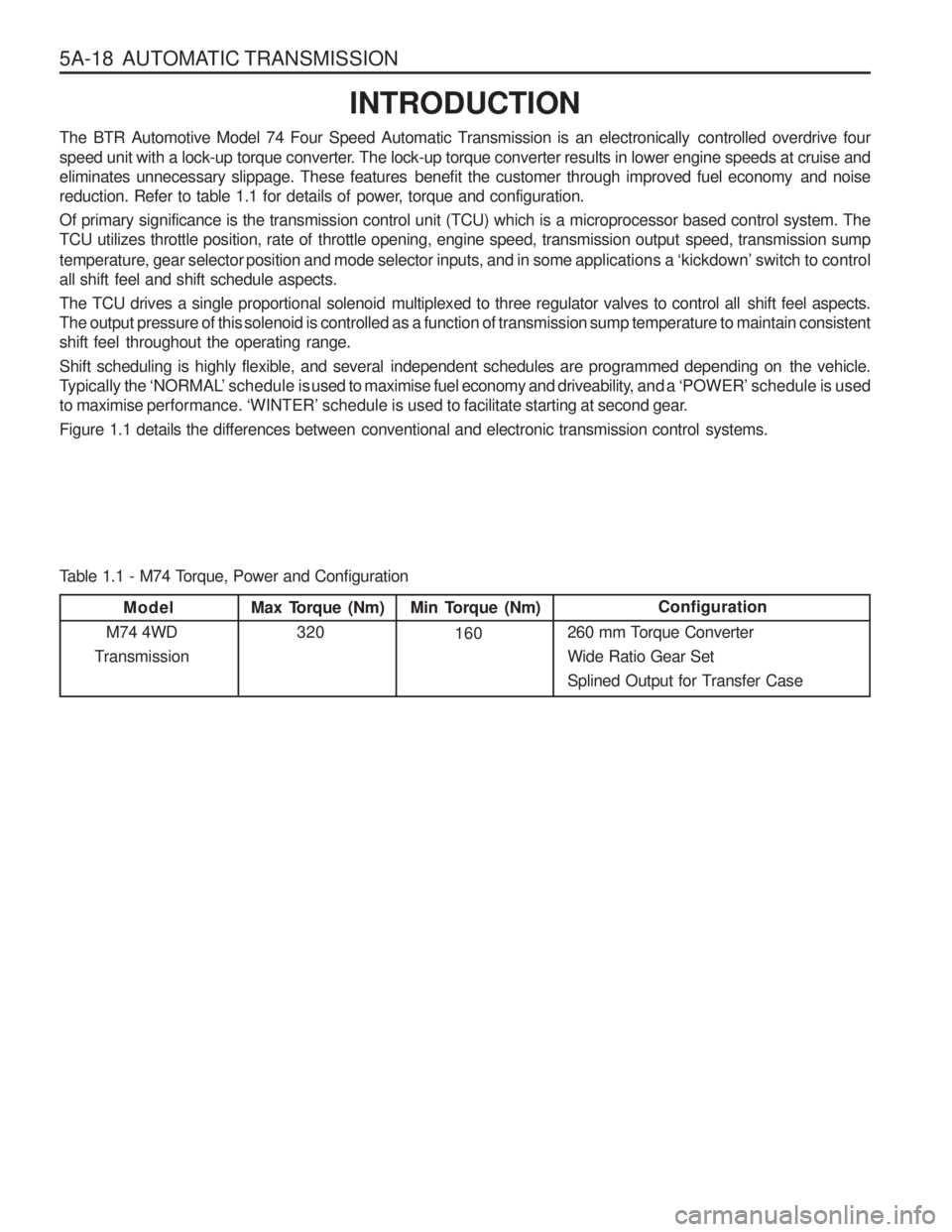
5A-18 AUTOMATIC TRANSMISSIONINTRODUCTION
The BTR Automotive Model 74 Four Speed Automatic Transmission is an electronically controlled overdrive four
speed unit with a lock-up torque converter. The lock-up torque converter results in lower engine speeds at cruise and
eliminates unnecessary slippage. These features benefit the customer through improved fuel economy and noise
reduction. Refer to table 1.1 for details of power, torque and configuration.
Of primary significance is the transmission control unit (TCU) which is a microprocessor based control system. The
TCU utilizes throttle position, rate of throttle opening, engine speed, transmission output speed, transmission sump
temperature, gear selector position and mode selector inputs, and in some applications a ‘kickdown’ switch to control
all shift feel and shift schedule aspects.
The TCU drives a single proportional solenoid multiplexed to three regulator valves to control all shift feel aspects.
The output pressure of this solenoid is controlled as a function of transmission sump temperature to maintain consistent
shift feel throughout the operating range.
Shift scheduling is highly flexible, and several independent schedules are programmed depending on the vehicle.
Typically the ‘NORMAL’ schedule is used to maximise fuel economy and driveability, and a ‘POWER’ schedule is used
to maximise performance. ‘WINTER’ schedule is used to facilitate starting at second gear.
Figure 1.1 details the differences between conventional and electronic transmission control systems.
Max Torque (Nm)
320 Configuration
260 mm Torque Converter Wide Ratio Gear Set
Splined Output for Transfer CaseMin Torque (Nm) 160
Model
M74 4WD
Transmission
Table 1.1 - M74 Torque, Power and Configuration
Page 881 of 1574

5A-22 AUTOMATIC TRANSMISSIONCONTROL SYSTEMS
GENERAL
There are two control systems associated with the transmission. The electronic control system monitors vehicle
parameters and adjusts the transmission performance. The hydraulic control system implements the electronic controlsystem commands. ELECTRONIC CONTROL SYSTEM
The electronic control system is comprised of sensors, a TCU and seven solenoids. The TCU reads the inputs, and
under software control activates the outputs according to values stored in read only memory (ROM).
The TCU controls the hydraulic control system. This control is via the hydraulic valve body, which contains seven
electro-magnetic solenoids. Six of the seven solenoids are used to control the line pressure, operate the shift valves
and the torque converter lock-up clutch, and to turn on and off the two regulator valves (The two regulator valvescontrol the shift feel.).
The seventh solenoid is the proportional or variable pressure solenoid (VPS) which works with the two regulator
valves to control shift feel.
Figure 3.1 details a typical TCU control system schematic.
The individual component locations, operation and specifications which make up the electronic control subsystem are covered in this section.
Figure 3.1 - Typical TCU Control System Schematic
Page 883 of 1574
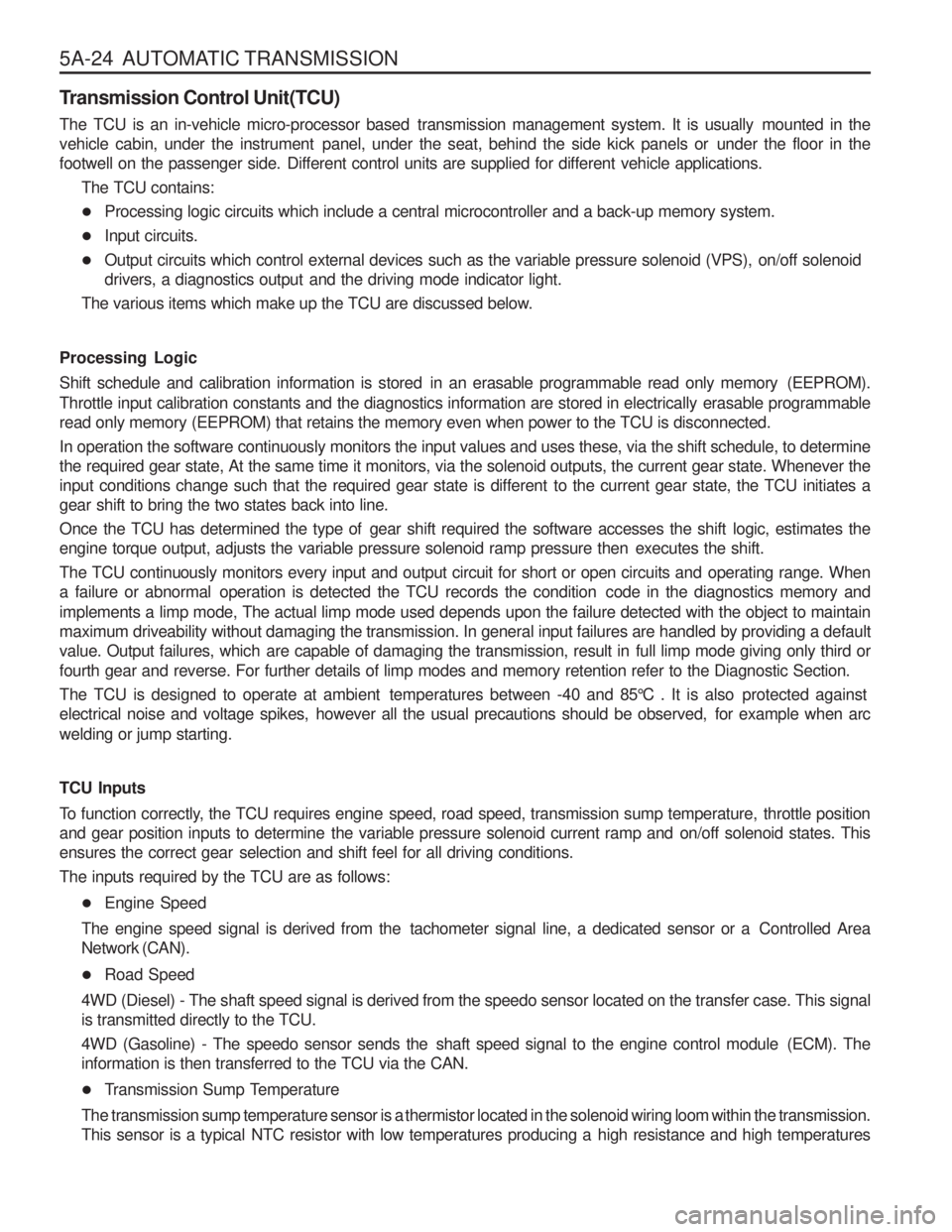
5A-24 AUTOMATIC TRANSMISSION
Transmission Control Unit(TCU)
The TCU is an in-vehicle micro-processor based transmission management system. It is usually mounted in the
vehicle cabin, under the instrument panel, under the seat, behind the side kick panels or under the floor in the
footwell on the passenger side. Different control units are supplied for different vehicle applications.The TCU contains:
� Processing logic circuits which include a central microcontroller and a back-up memory system.
� Input circuits.
� Output circuits which control external devices such as the variable pressure solenoid (VPS), on/off solenoid
drivers, a diagnostics output and the driving mode indicator light.
The various items which make up the TCU are discussed below.
Processing Logic
Shift schedule and calibration information is stored in an erasable programmable read only memory (EEPROM).
Throttle input calibration constants and the diagnostics information are stored in electrically erasable programmable
read only memory (EEPROM) that retains the memory even when power to the TCU is disconnected. In operation the software continuously monitors the input values and uses these, via the shift schedule, to determine the required gear state, At the same time it monitors, via the solenoid outputs, the current gear state. Whenever the
input conditions change such that the required gear state is different to the current gear state, the TCU initiates a
gear shift to bring the two states back into line.
Once the TCU has determined the type of gear shift required the software accesses the shift logic, estimates the
engine torque output, adjusts the variable pressure solenoid ramp pressure then executes the shift.
The TCU continuously monitors every input and output circuit for short or open circuits and operating range. When
a failure or abnormal operation is detected the TCU records the condition code in the diagnostics memory and
implements a limp mode, The actual limp mode used depends upon the failure detected with the object to maintain
maximum driveability without damaging the transmission. In general input failures are handled by providing a default
value. Output failures, which are capable of damaging the transmission, result in full limp mode giving only third or
fourth gear and reverse. For further details of limp modes and memory retention refer to the Diagnostic Section.
The TCU is designed to operate at ambient temperatures between -40 and 85°C . It is also protected against
electrical noise and voltage spikes, however all the usual precautions should be observed, for example when arc welding or jump starting. TCU Inputs
To function correctly, the TCU requires engine speed, road speed, transmission sump temperature, throttle position
and gear position inputs to determine the variable pressure solenoid current ramp and on/off solenoid states. This
ensures the correct gear selection and shift feel for all driving conditions. The inputs required by the TCU are as follows: � Engine Speed
The engine speed signal is derived from the tachometer signal line, a dedicated sensor or a Controlled Area Network (CAN).
� Road Speed
4WD (Diesel) - The shaft speed signal is derived from the speedo sensor located on the transfer case. This signal is transmitted directly to the TCU.
4WD (Gasoline) - The speedo sensor sends the shaft speed signal to the engine control module (ECM). The
information is then transferred to the TCU via the CAN.
� Transmission Sump Temperature
The transmission sump temperature sensor is a thermistor located in the solenoid wiring loom within the transmission.
This sensor is a typical NTC resistor with low temperatures producing a high resistance and high temperatures
Page 884 of 1574

AUTOMATIC TRANSMISSION 5A-25
producing a low resistance.
Temperature/Resistance characteristics and location within the solenoid wiring loom are given in tables 3-1 and 3- 2, and figures 3.2 and 3.3.
If the transmission sump temperature exceeds 135°C, the TCU will impose converter lock-up at lower vehicle
speeds and in some vehicles flashes the mode indicator lamp. This results in maximum oil flow through the
external oil cooler and eliminates slippage in the torque converter. Both these actions combine to reduce the oil
temperature in the transmission.
Connects To
Solenoid 1 Solenoid 2Solenoid 3Solenoid 4Solenoid 5 Solenoid 6 Solenoid 7Solenoid 5
Temp Sensor
Temp SensorWire Color Red
Blue
Yellow
Orange GreenViolet
Brown
Green White WhitePin No.
1 2345 6 789
10
Table 3.2 - Pin No. Codes for Temperature Sensor Location In Solenoid Loom
Figure 3.3 - Temperature Sensor Location in Solenoid Loom
Page 890 of 1574
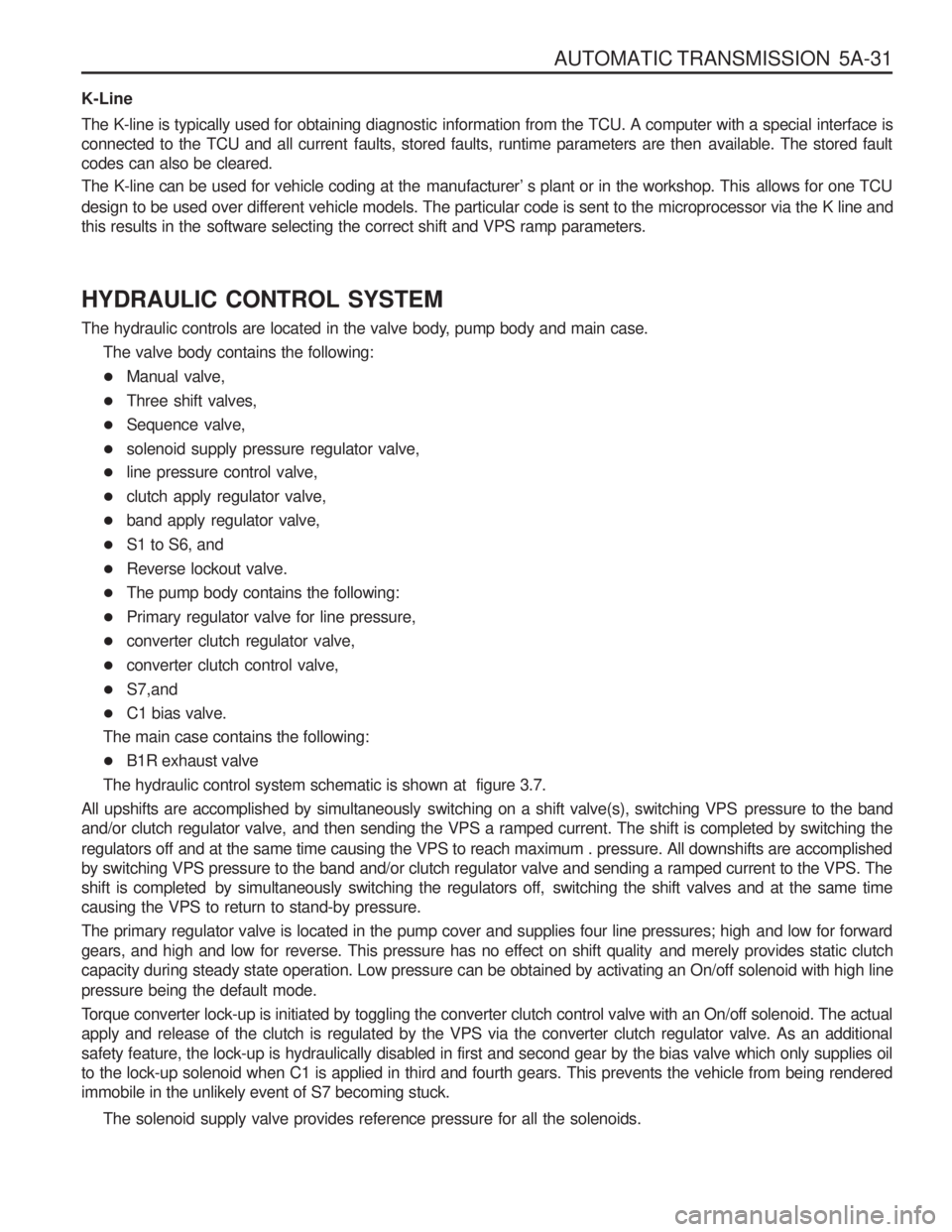
AUTOMATIC TRANSMISSION 5A-31
K-Line
The K-line is typically used for obtaining diagnostic information from the TCU. A computer with a special interface is
connected to the TCU and all current faults, stored faults, runtime parameters are then available. The stored faultcodes can also be cleared.
The K-line can be used for vehicle coding at the manufacturer’ s plant or in the workshop. This allows for one TCU
design to be used over different vehicle models. The particular code is sent to the microprocessor via the K line and
this results in the software selecting the correct shift and VPS ramp parameters. HYDRAULIC CONTROL SYSTEM
The hydraulic controls are located in the valve body, pump body and main case.The valve body contains the following:
� Manual valve,
� Three shift valves,
� Sequence valve,
� solenoid supply pressure regulator valve,
� line pressure control valve,
� clutch apply regulator valve,
� band apply regulator valve,
� S1 to S6, and
� Reverse lockout valve.
� The pump body contains the following:
� Primary regulator valve for line pressure,
� converter clutch regulator valve,
� converter clutch control valve,
� S7,and
� C1 bias valve.
The main case contains the following:
� B1R exhaust valve
The hydraulic control system schematic is shown at figure 3.7.
All upshifts are accomplished by simultaneously switching on a shift valve(s), switching VPS pressure to the band
and/or clutch regulator valve, and then sending the VPS a ramped current. The shift is completed by switching the
regulators off and at the same time causing the VPS to reach maximum . pressure. All downshifts are accomplished
by switching VPS pressure to the band and/or clutch regulator valve and sending a ramped current to the VPS. The
shift is completed by simultaneously switching the regulators off, switching the shift valves and at the same timecausing the VPS to return to stand-by pressure.
The primary regulator valve is located in the pump cover and supplies four line pressures; high and low for forward
gears, and high and low for reverse. This pressure has no effect on shift quality and merely provides static clutch
capacity during steady state operation. Low pressure can be obtained by activating an On/off solenoid with high line pressure being the default mode.
Torque converter lock-up is initiated by toggling the converter clutch control valve with an On/off solenoid. The actual apply and release of the clutch is regulated by the VPS via the converter clutch regulator valve. As an additionalsafety feature, the lock-up is hydraulically disabled in first and second gear by the bias valve which only supplies oilto the lock-up solenoid when C1 is applied in third and fourth gears. This prevents the vehicle from being renderedimmobile in the unlikely event of S7 becoming stuck.
The solenoid supply valve provides reference pressure for all the solenoids.
Page 901 of 1574

5A-42 AUTOMATIC TRANSMISSIONPOWER TRAIN SYSTEM
The Power Train System consists of: � A torque converter with single face lock-up clutch
� Four multi-plate clutch assemblies
� Two brake bands
� Two one-way clutches
� Planetary gearset
� Parking mechanism
A conventional six pinion Ravigneaux compound planetary gearset is used with overdrive (fourth gear) being obtained
by driving the carrier.
The cross-sectional arrangement is very modular in nature. Four main sub-assemblies are installed within the case
to complete the build. These sub-assemblies are: � Gearset-sprag-centre support
� C1 -C2-C3-C4 clutch sub-assembly
� Pump assembly
� Valve body assembly
One, or a combination of selective washers are used between the input shaft flange and the number 4 bearing to
control the transmission end float. This arrangement allows for extensive subassembly testing and simplistic finalassembly during production.
A general description of the operation of the Power Train System is detailed below. Refer to table 4.1 and figure 4.1.
First gear is engaged by applying the C2 clutch and locking the 1-2 One Way Clutch (1-2 OWC). The 1-2 shift is
accomplished by applying the B1 band and overrunning the 1-2 OWC. The 2-3 shift is accomplished by applying the
C1 clutch and releasing the B1 band. The 3-4 shift is accomplished by re-applying the B1 band and overrunning the
3-4 OWC. Reverse gear is engaged by applying the C3 clutch and the B2 band.
The C4 clutch is applied in the Manual 1,2 and 3 ranges to provide engine braking. In addition, the C4 clutch is also
applied in the Drive range for second and third gears to eliminate objectionable freewheel coasting. The B2 band is
also applied in the Manual 1 range to accomplish the low-overrun shift.
Both the front and rear servos are dual area designs to allow accurate friction element matching without the need for
secondary regulator valves. All the friction elements have been designed to provide low shift energies and high static
capacities when used with the new low static co-efficient transmission fluids. Non-asbestos friction materials are used throughout.
Gear
First
Second ThirdFourth
Reverse
Manual 1 Gear
Ratio 2.741 1.508 1.0000.7082.4282.741 C1
XX C2
X X XX X C3
X C4
X X B1
X X X B2
X X 1-2
OWC X 3-4
OWC X XX LU
CLUTCH
X*X
ELEMENTS ENGAGED
* For Certain Vehicle Applications, Refer to the Owner's Manual.
Table 4.1 - Engaged Elements vs Gear Ratios
Page 902 of 1574

AUTOMATIC TRANSMISSION 5A-43
Figure 4.1 - Power Flow Diagram TORQUE CONVERTER
The torque converter (refer figure 4.2) consists of a turbine,
stator pump, impeller and a lock-up damper and piston
assembly. As in conventional torque converters, the impeller is
attached to the converter cover, the turbine is splined to the
input shaft and the stator is mounted on the pump housing via
a one way clutch (sprag).
The addition of the damper and piston assembly enables the
torque converter to ‘lock-up’ under favourable conditions. Lock-
up is only permitted to occur in third and fourth gears under
specified throttle and road speed conditions.
Lock-up is achieved by applying hydraulic pressure to the
damper and piston assembly which couples the turbine to the
converter cover, locking-up the converter and eliminating
unwanted slippage. Whenever lock-up occurs, improved fuel
consumption is achieved. Torsional damper springs are
provided in the damper and piston assembly to absorb anyengine torque fluctuations during lock-up. Figure 4.2 - Torque Converter Cross Section